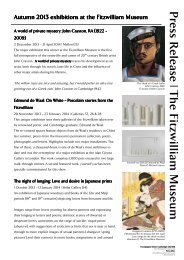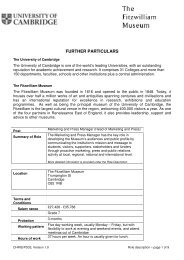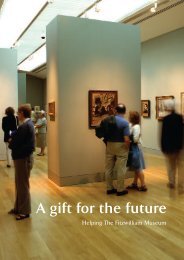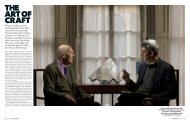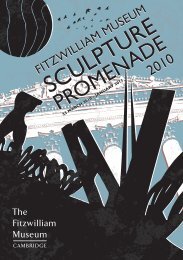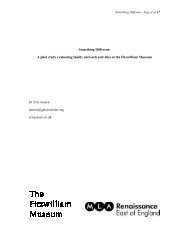The Fitzwilliam Museum - University of Cambridge
The Fitzwilliam Museum - University of Cambridge
The Fitzwilliam Museum - University of Cambridge
Create successful ePaper yourself
Turn your PDF publications into a flip-book with our unique Google optimized e-Paper software.
Conservator Lucy Skinner makes a detailed examination <strong>of</strong> the face <strong>of</strong> the inner c<strong>of</strong>fin <strong>of</strong> Nespawershefyt<br />
inside and out, with scenes taken from the Book <strong>of</strong><br />
the Dead and other funerary literature <strong>of</strong> the period.<br />
<strong>The</strong> decoration has a characteristic almost golden<br />
glow, largely due to the varnish used at the time. It is<br />
likely to have been less yellow when originally<br />
applied and has darkened over the centuries.<br />
Studies <strong>of</strong> the c<strong>of</strong>fins included x-radiography and CTscanning,<br />
thanks to the co-operation <strong>of</strong> colleagues at<br />
Addenbrooke’s hospital. <strong>The</strong>se <strong>of</strong>ten revealed<br />
constructional secrets hidden behind beautiful exteriors.<br />
Wood has always been an expensive raw material in<br />
Egypt and the ancient craftsmen were clearly careful to<br />
keep <strong>of</strong>fcuts to use as patches to fill gaps, and wood was<br />
<strong>of</strong>ten reused. In the case <strong>of</strong> Nespawershefyt’s mummy<br />
board, the x-rays revealed that the board is constructed<br />
from two planks joined together using loose tenons and<br />
dowels. <strong>The</strong>ir exterior finish is so well preserved that<br />
there is little hint <strong>of</strong> this fact from simple observation.<br />
X-rays also showed that the lid <strong>of</strong> the inner c<strong>of</strong>fin had<br />
split whilst it was being assembled, possibly as the result<br />
<strong>of</strong> drilling a dowel hole to affix the separately carved<br />
face. <strong>The</strong> resulting repair was visible in the form <strong>of</strong> a<br />
butterfly cramp joining the two parts <strong>of</strong> plank with the<br />
gap between them being filled with a coarse plaster,<br />
before the decoration was applied.<br />
<strong>The</strong> x-rays and scans were also used to inform the<br />
process <strong>of</strong> conservation; for example, they assisted in<br />
identifying the precise location and nature <strong>of</strong> old<br />
repairs, some <strong>of</strong> which involved the use <strong>of</strong> iron<br />
screws liable to corrosion and therefore a potential<br />
source <strong>of</strong> damage to the objects.<br />
Conservation consisted <strong>of</strong> cleaning, stabilizing loose<br />
elements, re-joining detached fragments and, where<br />
appropriate, the removal <strong>of</strong> old restorations, for<br />
example the screws already mentioned and a<br />
substantial reconstruction and over-painting <strong>of</strong> the<br />
wig lappets <strong>of</strong> Nespawershefyt’s inner c<strong>of</strong>fin lid. A<br />
detail noted by Lucy Skinner, the conservator<br />
involved, was the application <strong>of</strong> an additional area <strong>of</strong><br />
varnish in certain areas, which proved to be the texts<br />
containing Nespawershefyt’s job titles. After careful<br />
study <strong>of</strong> all the examples <strong>of</strong> the titles on the c<strong>of</strong>fin<br />
set, Helen Strudwick, an Egyptologist working as<br />
39<br />
Research



